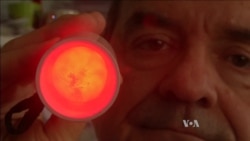It can be hard to make sense of what is going on with bees around the world.
But we do know a few things: neonicotinoids, a class of pesticide used by commercial farmers in the United States, can make bees more susceptible to illness and infestation by parasites like the Varroa mite.
We also know that in 2006, beekeepers began reporting a big problem: in some cases, 50 to 90 percent of the bees in their hives were just disappearing. These massive losses got the collective name Colony Collapse Disorder.
We also know that bees are big money. They pollinate an estimated 15 billion dollars of U.S. produce a year. That alone was enough to scare the heck out of farmers and grocers everywhere.
But, we also know, according to the U.S. Environmental Protection Agency, that "reported cases of CCD have declined substantially over the last five years." And domesticated bee hives seem to be on the comeback trail.
And just about a year ago, the EPA put out an enormous reseach paper that concluded that neonicotinoids can indeed pose a risk to the health of domesticated honeybees. The report went into great detail on the effects of the most common neonicotinoid, imidacloprid, and found that neonicotinoids don't cause much harm when used on "corn, berries and tobacco," but can be absorbed in great enough amounts to do damage when sprayed on cotton and citrus plants. The U.S. is coming to the game pretty late because Europe banned the use of imidacloprid in 2013.
New research sheds light on how the damage is done
When you lay out all this information on paper, what becomes clear is that a lot of what's happening in the bee world is still a mystery, especially why exactly domesticated bees are on the comeback trail. But there is no question that neonicotinoids, particularly imidacloprid, can do a lot of damage to bees when enough of it gets into their systems, and their hives and honey.
That's the focus of some new research from University College London. VOA spoke with Glen Jeffery, one of the authors of a paper being published today in PLoS One on neonicotinoids and bees. Jeffery's work focused on how neonicotinoids affect the bees on a cellular level, specifically how the pesticides affect mitochondria. "Mitochondria are the batteries in our cells that make the energy they need in the form of ATP," a molecule that transports the energy, he explained. "Mitochondrial decline is a key feature of the action of the insecticide, so ATP goes down when bees are exposed to it."
In other words, the pesticide pushes the bee's cells into overdrive and they use up all their energy, and then just simply become immobile, unable to move or feed themselves and they die of starvation.
Seeing a solution in light
But science is a funny thing. Jeffery and his team were initially doing research on aging, not necessarily bees, so they knew that "...mitochondrial function can be improved with specific wavelengths of light" and light therapy was shown to improve mobility and life span in flies.
And here's the great part: Jeffery says the idea of using a similar therapy on bees "occurred to me (a visual scientist) cycling home in the rain after reading about the mode of action of the insecticide and I thought that the light should help."
So, he took the idea to the lab. "The researchers used four groups of bees from commercial hives, with more than 400 bees in each colony. Two groups were exposed to a neonicotinoid, Imidacloprid, for ten days, with one group also being treated with light therapy over the same period."
Jeffery says he was "surprised by the positive impact." The bees that were poisoned but got light therapy "had significantly better mobility and survival rates, living just as long and functioning just as well as bees that had not been poisoned," while the bees that didn't get light therapy showed less mobility and higher death rates.
The team also found that the light therapy -- "15 minutes of near infrared light (670nm) twice daily" -- didn't affect the bees' behavior because they can't see the light. So now Jeffery says he and his team are "working to develop a small device that can be fitted into a commercial hive, which could be an economic solution to a problem with very widespread implications."
Talk about seeing the light.









